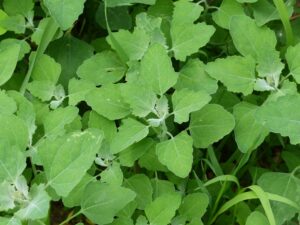For years we’ve added wild foraged plants to our diet. They’re free, available, often delicious, and give us the satisfaction of knowing that we can find food close to home.
After years of foraging and trying many wild foods, we now place them into three categories:
- Common, easily gathered and prepared, and tasty.
- Tasty plants but tedious to gather and prepare. Often we just don’t have the patience and time to gather and cook them.
- Ones that are difficult and time-consuming to gather and prepare, and are not especially tasty. These would be worthy food in an emergency but not normally worth the time and effort to gather and prepare.
We concentrate on the first category and one of our favorites is lambsquarters. It’s common just about everywhere. We’ve spotted it beside urban sidewalks, on the edge of farm fields, and in nearly every garden. The plant springs up like magic between rows of vegetables, and too often the gardener rips or hoes them out as weeds. It used to have more respect here. People in some countries still honor and harvest lambsqurter.
Easy Peasy Lambsquarter
Lambsquarters are as delicious as any vegetable we plant in our garden. We don’t need to buy seeds and plant them. They just appear like magic and grow fast as soon as the weather warms. We begin eating them about bean and pumpkin planting time.
Lambsquarters are sometimes called pigweed, goosefoot, wild spinach, or wild beet. They are an amaranth and often grow in large clumps. An easy way to identify them is to examine the top of young plants and the bottom side of leaves. They look white, and drops of water readily slide off.
Like most garden and wild greens, lambsquarters are best harvested when the leaves are new and small. Big summer leaves become tough and bitter. To speed up gathering we sometimes use a big pair of garden scissors to snip them off. Then we thoroughly rinse them to wash off any grit.
Young lambsquarter leaves can be added to salads, but we usually steam them for a few minutes. They’re delicious with a touch of melted butter.
- A prolific edible.
- We use scissors to snip the tender lambsquarter leaves.
Beware: Before we eat any wild plant new to us we do the following:
- Positively Identify the plant from at least two sources. For example, we confirm identification from any combination of wild food books, credible Internet sites, or knowledge gained first hand from a wild food expert.
- Avoid collecting plants that may be contaminated by farm or lawn chemicals, car fumes, or animal feces or urine.
- Thoroughly wash the plants two or three times.
- Follow cooking or eating instructions found in foraging books or credible Internet sites.
- Eat sparingly the first time. A plant may be perfectly edible for most people but others could be allergic to it. Assuming there’s no digestive problem or adverse reaction after eating a small taste we then enjoy larger servings.
Lambsquarters are delicious, prolific, and are ready to pick all summer. We add them to our meals often. This addition of a nutritious food helps us be less dependent upon the grocery store for our dinner.




My father grew up poor in a small town in central Iowa in the 1930s. He said his family ate lambsquarters regularly. He remembered it as being quite tasty. I will keep my eyes open for it and will give it a try!
Sheri, thanks for this comment. By now, lambsquarter is getting tough, although there are still patches of smaller ones. Take the top few leaves, rinse off, steam, eat with butter salt and pepper.